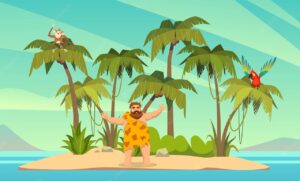The history of The Hobbit began about ninety years ago – in the late twenties of the last century. Once upon a time, there was a professor in Oxford. Not some student or teacher there – no, a real professor of the Anglo-Saxon language! He was friendly with other professors, was in an informal club of lovers of ancient literature, and was married. He had sons, John, Michael, and Christopher, and a daughter, Priscilla.
Almost eight decades later, The Hobbit is a favorite book for many generations of readers worldwide. It has been translated into more than forty languages, filmed several times, computer and board games, opera, and children’s performances were made on its basis, and stamps were issued in his honor.
Beginning of the Fantasy World
With this book, Tolkien entered literature. Initially, it arose as a work for the family circle – Tolkien began to tell the Hobbit’s tale to his children.
Appearing almost by accident in print, the story gained wide popularity among readers of all ages. Already in this fairy tale, a huge mythological layer was laid. The book is known more as The Lord of the Rings prologue.
And yet it was still very far from the fairy tale we love. The story was overgrown with details that sometimes baffled Tolkien himself. Only over time, what appeared as details incomprehensible to him, began to fit into a clear and consistent picture … well, almost constant.
About “The Hobbit, or There and Back Again”

The plot is based on the journey of the Hobbit Bilbo Baggins, the wizard Gandalf and 13 dwarves led by Thorin Oakenshield. Their path lies to the Lonely Mountain, where the dwarven treasures are located, captured, and guarded by the dragon Smaug.
Tolkien drew on Norse mythology and the Old English poem Beowulf when writing The Hobbit. According to a number of researchers, the experience of the writer’s participation in the First World War was reflected in the story. A characteristic feature of the work is the opposite of the old and modern standards of behavior, in particular, the style of the characters’ speech.
The main character, Bilbo Baggins, has many characteristics of a modern person and, as a result, looks like an obvious anachronism against the ancient world’s background. Accordingly, the work raises the question of the relationship between a person of modern culture and the ancient heroes surrounding him.
It is possible that, at first, Bilbo was not a hobbit. Perhaps it was just a story about a short man who loved comfort, who once, together with a wizard and gnomes, went to distant lands. And then, a few years after the story was told to the children, Tolkien checked those notorious works, wrote down the first phrase – and thus began composing a literary rather than an oral fairy tale. Bilbo, the first hobbit character of Middle-earth, differs from the dwarves, elves, and even people around him not only in his modest skills but also in his normative value system.
Throughout the story, the protagonist’s development takes place – participation in adventures becomes a path of self-discovery for Bilbo. In the conflict for treasures, which arises in the late phase of the plot of the story, the problematic feeling of greed for material values and its overcoming is touched upon.
Popularity
The Hobbit was published by Allen & Unwin on September 21, 1937. The first edition of the story consisted of 1500 copies. The book was in great demand among buyers, so preparing a second issue for Christmas became necessary. In early December, the publishing house released an additional circulation of 2,300 copies.
The distribution of the book was hindered by the Second World War – from 1940 to 1949, and there was a restriction on paper use in the UK. In addition, in November 1940, part of the book’s circulation was destroyed during the bombing, and until 1943 edition of The Hobbit was not available to buyers in the UK. However, the book sales increased significantly in the 1950s, especially after the publication of a sequel, The Lord of the Rings.
When creating The Hobbit, Tolkien had ample opportunities for experiments with different narration methods and a mixture of elements of other genres – from a picaresque novel to a heroic epic. Tolkien needed to move away from the patterns of children’s literature to create a kind of synthetic genre, the idea of which later embodied in full in Tolkien’s most famous work, The Lord of the Rings.
Journey For Future Generations
Even though at the time of the publication of The Hobbit, Tolkien was not known to anyone as a writer, by this time, he had already managed to experiment with various forms. His creative activity was diverse: having a personal interest in imitating ancient samples of poetry and epic, he simultaneously composed a lot for his children.



